Where do you stand today? Where do you see yourself in five years? In ten? In twenty?
If you find yourself lost for answers under the onslaught of this interrogation, you’re not alone. A surprising percentage of the human population sleepwalks their way through life, dragging a suitcase full of dead dreams and heavy regrets behind them. They feel unfulfilled and unsatisfied.
Why? Because they failed at chasing and realizing their dreams!
Here’s how you turn your dreams into reality: turn them into your goals.
Napoleon Hill famously said, “A goal is a dream with a deadline.” We think he hit the bull’s eye with this maxim. In this blog, we share with you some tried and tested ways to become a go-getter. Set your goals, devise an action plan, and achieve your goals like you never thought you could. Shape your future using these proven tips, starting now!
1. Spell Your Vision & Mission Statement
“Belong anywhere.”
The two impactful words are the mission statement of AirBnB. Short but powerful, they simplify the organization’s goal and convey it to people all over the world.
Likewise, the first step of setting your goal is to have a clear mission. What do you aim to achieve through your efforts? What difference is your startup going to create? Think hard and find clarity within. Then, come up with words that encapsulate your mission. You need them to know your starting point and define your path from the first step onward.
What is that path? It is your vision.
AirBnB’s vision statement explains their mission in detail: “Tapping into the universal human yearning to belong—the desire to feel welcomed, respected, and appreciated for who you are, no matter where you might be.”
Let’s break it down.
Your mission statement defines what you want to accomplish through your entrepreneurial project. It states your purpose and gives you a solid roadmap with tangible goals.
Your vision statement is a concise description of the broader impact you want to create. It encapsulates your aspirations and guides you as well as your team to work toward your common goal. It offers clarity of purpose and smooths out the internal decision-making process.
As you begin your journey of goal-setting, start by stating your mission and vision statement. We used WeekPlan to do this, and it did wonders for us. The app offers you a clean dashboard to define your mission and vision effectively. You can also easily refer to it regularly to stay aligned with your goals.
Whether you head a large corporation or are a new entrepreneur, keep checking your mission and mission statement. They help you achieve your ultimate milestones and announce your purpose to your target audience. It’s a simple yet rewarding act.
2. Define Your Core Values
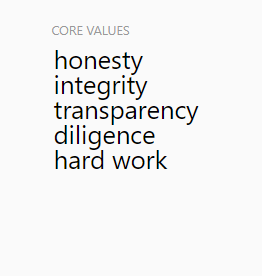
Honesty. Consistency. Independence. Loyalty. Optimism.
This is not a random assortment of adjectives. Instead, this is an example of the core values humans hold.
Your values form your fundamental belief system, guide your actions in life, and shape your identity. They can be negative or positive. In any case, they influence your behavior and mold your attitude to pretty much everything, including your personal, social, financial, and professional life. Your goals, too, depend heavily on your core values.
Though our values drive us, it’s another matter entirely whether you identify and acknowledge your values or your values subconsciously direct you to different life paths. It might come as a shocker to you that most of us are completely unaware of our core values.
What are your core values?
List fifty. Next, cut the list down to twenty-five. Keep going until you are left with only five - these are your core values. They define you. They also orient the academic, professional, and relational aspects of your life.
The fact is, you will feel little to no motivation to achieve your goals if they do not connect with your core values. For instance, if you value security, you will be an utter misfit in a volatile work environment. That’s because you need stability to function; its lack will lead to stress and eventual burnout.
So, before you set your goals, thoroughly investigate your core values. Make sure your intended goals are in line with your values and take measures to address any disconnect that might exist between them. Assess the different regions of your life - self, family, career, and community, and determine whether you are living by your values or against them. If you don’t live by your values, you will inevitably feel drained and unmotivated.
Companies, too, have core values. Also called corporate values, they form the basic guiding principles that propel you and your team to work toward a common goal. For example, Google has ten declared core values, including ‘focus on the user and all else will follow’ and ‘democracy on the web works.’ We all know they have remained true to their values by offering a search engine to everyone with an internet connection.
Whether you are a budding or seasoned entrepreneur, make sure your core values are clear to your team. Also, ensure that your actions align with your values. Here’s a pro tip: take your values seriously if you want to maintain standards. Write them out clearly on your WeekPlan dashboard. You will find goal achievement becomes smooth and fun if your actions match your words, and there is no internal dissonance!
3. Clarify Your Roles
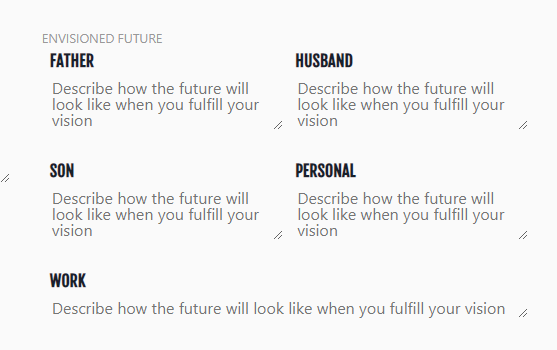
You wear several hats in life. You are someone’s partner, parent, and child. You are a friend, a colleague, and a mentor. You are a learner and a teacher. Your life can be divided into different sections according to the role you play in each. Accordingly, your goals change depending on the hat you put on.
It’s a great idea to view the different areas of your life through the lens of your various roles. As an active agent of change, you must realize and take responsibility for each of your roles. Also, know that each role comes with its own set of duties and expectations.
Assume the role of a parent, for instance. Your goals, in this case, include nurturing your child, helping them every day with their homework, coach the baseball team on weekends, take them to weekly piano lessons, and save up in the long run for their college tuition.
Assume the role of an entrepreneur. Your goal then becomes to sketch a viable business plan, build and train a team, set short- and long-term objectives, find your niche in the market, and manage your day-to-day operations. From a larger perspective, you also aim to create value and leave a legacy.
Consider also the role that you play for yourself; it is unarguably the most important one. In this domain, your goals include such things as regular self-care, learning a new skill, getting another degree, pursuing a hobby, following a new dream, and turning it into a reality.
Do you see how your goals shift according to your role?
In your goal-setting and achievement process, make sure to assess your different roles. Use WeekPlan to define your vision in each role you have taken on. Describe how you will attain that vision. A helpful trick is to visualize your future.
Envision your future as a parent, a successful entrepreneur, and a great mentor. See yourself as someone your child can trust, your team can look up to, and your students can follow. Feel the satisfaction yet?
Research shows people who connect their current selves with their future selves have considerably greater chances of success. We can also tell you it boosts your confidence and motivation. So start connecting your present to your future now! Choose your goals according to your values and remove any contradictions from the process. This is a foolproof way to ensure you keep working toward your ultimate destination.
4. Set Quarterly Goals
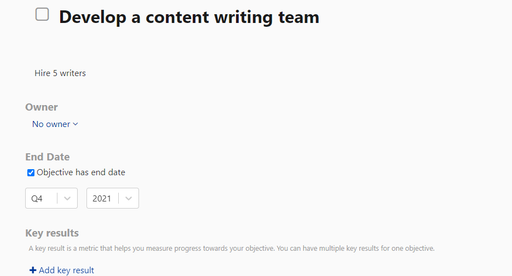
How often do you set goals, personal or professional? How frequently do you check up on their status?
Most people think up an objective they want to achieve, but as days turn into weeks into months, they don’t bother following up. As a result, when they revisit a particular goal a year or so later, they unsurprisingly find it still incomplete.
One way you can successfully achieve your goals is by using a continuous performance management system. If you’re an entrepreneur, pay attention. This latest business model is dynamic and helps drive success by increasing engagement and accountability.
Now, look at the screenshot attached above. The ‘Q’ represents one quarter of a year. This is an indication to you: start setting quarterly goals. This means you allocate four months from the year (the first or any other) to one particular objective. Put an end date to it, so you know the deadline. Work within that period to ensure you attain the goal you set for yourself.
Also, add ‘key result’ (or multiple key results) for each quarterly task so you can track your progress. Companies, as well as individuals, can use quarterly goals as it is one of the smartest and most effective strategies to achieve the objective.
It’s not wrong to dream big. However, if you force a huge and seemingly unrealistic goal on yourself and your team, you will create feelings of overwhelm. You will also inevitably set yourself up for failure. So, try going about your goals in an intelligent way.
Have a vision, and visualize the big picture. Let’s say your goal for the whole year is to hire and train a team for your content marketing department. Now, this goal will not materialize in a matter of days or even weeks. A better idea to measure and ascertain your progress is by breaking this one long-term goal of building a team into four quarters.
In this instance, you can dedicate the first quarter to hiring the team. In the second quarter, focus on training the individuals and measuring growth through performance metrics. In the third, hold workshops and offer professional courses to add further value. In the fourth, you can expand the existing team or introduce a hierarchy within it.
Do you see how breaking the one big goal into four small chunks makes it more doable? It also makes you feel more in control and increases accountability as you revisit the goal every four months. At the same time, you achieve the desired outcome since you have sufficient time to concentrate on one thing at one time.
Breaking your goals into quarters gives specificity to your vision. It also sets a clear direction for your team, who see an innovative and realistic plan to work on. As you achieve your first-quarter goal, you can celebrate it and boost overall morale! This builds momentum and keeps you going steadily forward. You can build on small successes, review progress, and feel empowered to achieve more and more goals down the line.
5. Use the Time Management Matrix
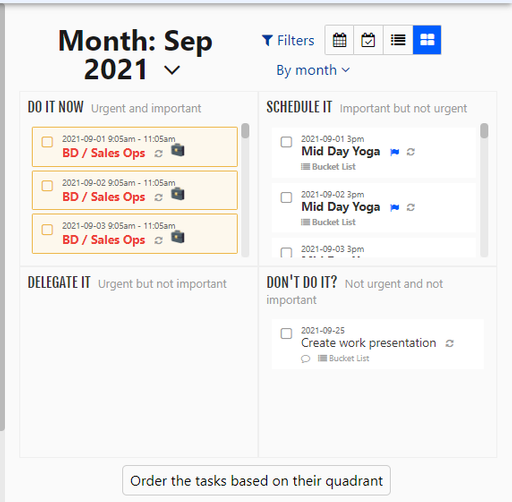
In his book, the 7 Habits of Highly Effective People, Steven Covey presented a highly effective model to increase efficiency and success. It’s known as ‘the time management matrix,’ and it helps you prioritize like a pro.
As a professional who has several personal and social obligations to fulfill as well, your plate might just be too full. You might find yourself inundated with several important things to do every day. Can you do them all? If you had more than 24 hours in a day, sure. But since you have a limited number of hours every day, some of which you must spend sleeping and taking time off, it’s safe to say you can only achieve so much.
In this case, discernment becomes crucial. How do you differentiate between what task needs to be done today without further delay, which one can be put off for another week, and which ones can be delegated? It seems like a complicated process, but you can simplify it using Covey’s matrix.
This is a powerful self-management tool that helps you manage your day and goals while maintaining your productivity. Using this method, you can divide your tasks into four categories:
- Urgent and important - e.g., addressing a customer’s complaint
- Not Urgent but important - e.g., making a presentation for the weekly meeting
- Urgent but not important - e.g., replying to your emails
- Neither urgent nor important - e.g., shopping for a new pair of shoes
Start carving up your tasks into these four categories, and you will discover your priority list. You can also identify tasks that are essentially time-wasters and which you can put on the backburner for an indeterminate time.
Use WeekPlan and set the status of each task - just press a few buttons, and you’ll have tasks of all four categories we described above. Click another button, and your tasks will be sorted into the quadrants, giving you a visual to use and plan your day, week, and month accordingly.
With WeekPlan, you can also get additional benefits like setting completion reminders for each task and receiving alerts via email or SMS. We’d recommend choosing to get notifications as this increases accountability. Overall, this method helps you stay on track, maximize your productivity and achieve every goal according to its priority.
6. Create Subtasks
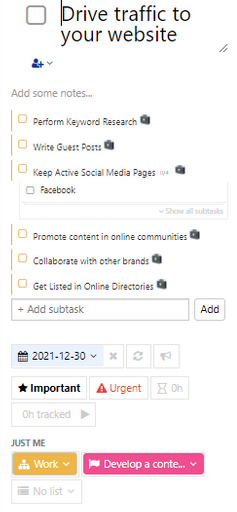
We already explored why it’s important to break a larger goal into doable chunks. This tip is related to it. However, here we will discuss how you can leverage the power of creating subtasks to ensure the achievement of goals. Listen closely because this tip is all about organization.
Start creating detailed actions plans. By this, we mean breaking a big task into several steps. This enables you to check all the aspects and ensure you meet all the objectives without missing a crucial step.
Often, as your team grows, the magnitude of your tasks does as well. You might find yourself handling large and complicated projects. How do you best explain it to your team and make sure they get the work done?
This is where subtasks come in handy. It helps you determine a cost and time-effective approach toward the completion of a bigger goal. You can track the day-to-day operations. Also, since the project is broken into subtasks, you can quickly isolate the bottleneck if a problem occurs. You can resolve the obstructions in the workflow, boost efficiency and ensure transparency.
Use WeekPlan to create detailed subtasks. Note that while one parent task can have several subtasks, each is standalone and equally important on its own. You can’t expect to skip one and move to the other one and get the same results.
With WeekPlan, you can sort your subtasks using a Gantt chart. This helps you schedule each task in a particular time slot while also giving you a visual picture of your progress. You can define the ‘when’ and ‘how’ of each subtask. Also, set starting as well as ending date/time.
This step is all about creating a high-level action plan. You have a bird’s eye view of the entire project; you know the individual steps and particular requirements. At the same time, you know the time each subtask will take. This is a detailed way of project planning, where you delineate each phase and keep track throughout. The progress bar ensures you know where you stand.
As you work with subtasks, you can guarantee your goals remain SMART - Specific, Measurable, Achievable, Relevant, and Time-based. As your objectives are planned out, time-tracked and clear to everyone, it makes it all the more easy to achieve the milestones one by one without stopping!
7. Start Weekly Planning

Planning out your entire week is effective as it ensures you schedule your priorities in the correct order. As you complete every task on your list, you can make sure you are on track with your short-term goals - and those ultimately lead to the fulfillment of your long-term goals!
WeekPlan, as the name suggests, helps you organize your calendar ahead of time and plan your entire week. It also helps you leverage the power of the OKR framework - Objectives and Key Results - to set and attain goals. You can go about it in three ways: define your day, week, and month. This helps you keep your goals measurable and track the outcomes regularly.
What is an objective? It’s essentially the goal you set out to achieve. You can define it in concrete terms and take an action-oriented approach to attain it. Design it with care and assign a deadline accordingly. Your week’s plan can reflect the objective you have set for one day, the entire week, or the upcoming month.
What are Key Results? This refers to the benchmark you determine for yourself as you begin - the week or month, or year. This is the yardstick you refer to from time to time in order to ensure you are on track. It helps you monitor your path realistically and clearly.
In short, your objective is the ‘what’ - meaning the big picture. Your key results are the ‘how’ - meaning the goalposts. A combination of both gives you an effective strategy to ensure you keep progressing toward your destination. Use WeekPlan to sort your goals per the OKR framework. You can enable yourself and your team to accomplish more and focus on the big picture.
At the same time, with the app, you can prioritize tasks and set filters per your different roles (as discussed in tip#3). This gives you a clear picture of what you’re doing and what you’re supposed to do next in each area of your life. You can also automate recurring tasks, such as weekly meetings, daily workout sessions, or monthly company lunches. This saves the hassle of putting repetitive tasks on your to-do list each day.
You can also track the productive hours of each day and tally them up to see your productivity level on a weekly or monthly basis. Also, you can break your day or week into time chunks - so, for instance, you can allot 2 hours to a weekly meeting and make sure you finish it within time. Also, set aside time for unplanned events to be more in control of your schedule in advance.
Weekly planning gives you high visibility of your entire week and helps you measure your progress consistently. As you cross off tasks on your checklist, you’ll feel a sense of satisfaction enveloping you. It’s an excellent form of motivation that inspires you to keep moving forward!
8. Pomodoro Timer

Distractions are the enemy of goals. They take you off track, slow down your momentum and eventually delay the achievement of your objective.
For instance, you might set a deadline of two days to write a report. It’s enough time, and you’re sure you can do a great job. However, you have to attend pointless conferences at work. You find yourself going down the social media rabbit hole. An errant friend shows up, and you waste your time hanging out with them when you’ve got a project to finish. In the end, what should have taken two days takes five.
Do you see how distractions cause disruptions?
If you have tried and failed at handling distractions effectively, use the Pomodoro technique. This clever productivity management tool helps you stay focused on your goals, so you complete them on time.
The idea is straightforward: work for 25 minutes on a timer and then take a five-minute break. Repeat the process thrice. This completes one Pomodoro cycle. Take a fifteen to thirty minutes long break after it. You will find that in approximately one and a half hours of being laser-sharp focused, you get more things done than you previously did in one whole day.
You can use WeekPlan to employ the Pomodoro technique - the app comes integrated with the tool. Open your daily task list and start going through them one by one. Set the timer and obliterate distractions and procrastination.
Use these short bursts of high productivity to get things done. Twenty-five minutes of high focus not only optimize your efficiency but also motivate you to chase your goals persistently. You’re on a time limit, and you want to win! It’s a powerful method to keep going.
9. Practice Journaling

Journaling is an empowering tool for growth and goal-setting. When you journal, you put your goals in writing. Your aims are no longer just formless thoughts inside your head. Rather, they are out there now - concrete and with a visible shape. It’s effective because you can see (in words) what you’re aiming for; you can visualize your future based on those words.
Also, your own thought processes, behavioral patterns, and core values become clearer to you through journaling. You can chart your journey from the beginning and ascertain the changes you make along the way. Most people feel frustrated because they can’t see themselves progressing. However, the truth is, they make progress step by step but cannot see it. Journaling takes care of that. With your transformation journey document, you can stay consistently motivated.
Worried about someone getting their hands on your journal and learning your innermost thoughts? Well, just ditch the old-fashioned way of keeping diaries and opt for using a secure online app like WeekPlan. It offers you a clean space to record your thoughts.
Furthermore, prompts such as ‘reflect on your day,’ ‘what have you learned?’ and ‘what could you have done better?’ help you recap your daily activities and put things in perspective. You can journal on the side while making detailed action plans and tracking your long-term goals.

If you’re not in the mood to write long diary entries, use its modern alternative: Mirco-journal! Touted as the Twitter of journaling, micro-journaling is all about putting your thoughts in concise words. Consider them as keywords that define what’s topmost on your mind.
This practice is also called cogitorama - ‘cogito’ means thought in Latin, and ‘-orama’ means see in Greek. Using this strategy, you can write the essential things - begin with a neutral word, then write a positive and a negative experience. For instance, our cogitorama for Monday would be something like this: weekly planning + SMART goals - workplace conflict. See how it gives you the entire gist of the day?
Richard Branson, entrepreneur par excellence, said, “Ever since I was a child I have made lists of all kinds, including short-term tasks, long-term goals, and resolutions.” Well, take his word if not ours and start journaling now! This is what will help you create your future. Do it when you need to weigh your options, find clarity, and track your goals. It keeps you aware of your progress, so you never falter.
10. Keep a Backlog

Whether it’s reading a new book from your favorite author, studying a new business theory, experimenting with a new product idea - you’d have a lot of stuff you want to explore. However, since it’s not urgent, you put it on the back burner and forget about it until later.
It’s a great idea to keep a bucket list for your future. It’s not just a whim or fancy. Rather, it is a crucial part of strategic planning. Today, you focus on what’s urgent and important. However, save your brilliant ideas and inspirations to explore down the line. You should never give up on the pursuit of new experiences due to obligations. Always leave some room for joy, wonder, and curiosity - this is what bucket lists are all about.
So, in the process of goal-setting, we encourage you to keep a backlog. It’s essentially a record of your dreams. These are tasks that are not time-bound. You are at leisure to store them, forget about them, and revisit them later once you have some time on your hands. This is a great way to gather your ideas and boost your drive to achieve them sooner or later.
Since your backlog is continuous in nature, you can keep adding things to this list. However, avoid clutter and make sure to snip your backlog every month. This way, you save only things that are truly important to you. Stay organized, clear-headed, and inspired to keep attaining your goals, one at a time!
In Conclusion
Successful people who are at the top of their game and regarded as experts in their fields have one thing in common: they define their goals before setting out to achieve them! They know what they want from life, they plan for it, and they get it. We’re sure you have what it takes to belong to the above category of driven individuals.
Pablo Picasso said, “Our goals can only be reached through a vehicle of a plan, in which we must fervently believe, and upon which we must vigorously act. There is no other route to success.”
In simpler words, one thing is certain: you can’t reach your destination if you don’t know what it is and don’t have the directions to it. Resolve this problem by defining your goals from here on out. Use the credible tips we have shared above with you and craft the future you want for yourself.
It’s time you take charge of your life and lead it in the direction of your dreams!

More Posts
13 Time Management Tips for Middle School Students
Managing time is key for middle school students. They have school, hobbies, homework, and chores. Learning time management helps them do well in today's world. They learn to choose what's most important, stay organized, and...
11 Common Mistakes to Avoid in A Weekly Progress Report
A Weekly Progress Report is key for sharing what we did, what we faced, and what we plan to do next. It shows what we've done, what we're facing now, and what we...
Best OKR Software with Analytics To Transform Your Business
![The Best OKR Software with Analytics]() In the complex tapestry of modern business operations, the need for direction, clarity, and focus has never been more critical. Enter OKR (Objectives and Key Results) software:...
7 Habits of Highly Effective People Book Summary
"The 7 Habits of Highly Effective People" by Stephen R. Covey is a key guide in personal development. This book, first released in 1989, is now in its 25th edition. It shares insights...